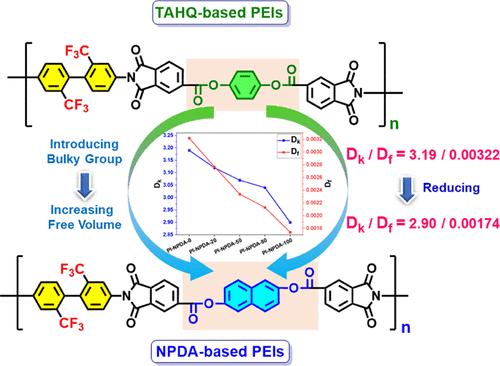通过含氟基的热稳定萘基聚(酯-亚胺)实现低耗散系数和低介电常数
IF 8.2
2区 材料科学
Q1 MATERIALS SCIENCE, MULTIDISCIPLINARY
引用次数: 0
摘要
近年来,聚酰亚胺(PIs)及其功能衍生物(即聚(酯-亚胺)s (PEIs),聚(酰胺-亚胺)s (PAIs)等)因其优异的热机械稳定性,耐热性,介电性能和溶液加工性能而在微电子和光电工业中受到越来越多的关注。然而,开发在高频(≥10 GHz)下具有低介电常数(Dk)和低耗散因子(Df)的pi对于先进的移动通信和高频应用至关重要。因此,为了在高频率下实现Dk和Df的低介电性能,使用具有强吸电子氟基团的pei是一种很好的合成策略。本文以2,2′-双(三氟甲基)-[1,1′-联苯]-4,4′-二胺(TFMB)、1,4-苯基双(1,3-二氧基-1,3-二氢异苯并呋喃-5-羧酸盐)(TAHQ)和萘-2,6-二基双(1,3-二氧基-1,3-二氢异苯并呋喃-5-羧酸盐)(NPDA)为单体制备了一系列具有三氟甲基(−CF3)基团的PEIs。此外,TAHQ/NPDA的摩尔比调节了衍生PEI膜的综合性能,并对PEI膜的各项性能进行了详细的讨论。理论计算表明,在TFMB/TAHQ体系中,当NPDA比从0增加到100%时,摩尔自由体积增加,极化率和线性度达到平衡,有利于实现低介电性能。因此,所有PEI薄膜都表现出优异的热稳定性,在470°C以上,热分解温度为失重5% (Td5%),玻璃化转变温度(Tg)为215-250°C。此外,所有PEI薄膜在16-40 ppm/°C范围内具有良好的热膨胀系数(CTE)和良好的机械稳定性。此外,所有PEI薄膜在高频下都表现出低介电性能。在10 GHz频率下,当NPDA浓度从0增加到100%时,二者的Dk/Df值逐渐降低,从PEI-NPDA-0的3.19/0.00322降至PEI-NPDA-100的2.90/0.00174。特别是,Df值是10ghz频率下的最低值之一。结果表明,用氟基制备PEI骨架是实现高频低介电性能的良好合成策略。本文章由计算机程序翻译,如有差异,请以英文原文为准。

Achieving Low Dissipation Factors and Low Dielectric Constants via Thermally Stable Naphthalene-Based Poly(ester-imide)s with Fluorine Groups
In recent years, polyimides (PIs) and their functional derivatives (i.e., poly(ester-imide)s (PEIs), poly(amide-imide)s (PAIs), etc.) have gained more attention in the microelectronic and optoelectronic industries because of their excellent thermal-mechanical stabilities, heat resistance, dielectric properties, and solution processabilities. Nevertheless, developing PIs with low dielectric constants (Dk) and low dissipation factors (Df) at high frequencies (≥10 GHz) is crucial for advanced mobile communications and high-frequency applications. Therefore, to achieve low dielectric properties in both Dk and Df at high frequencies, using PEIs with strong electron-withdrawing fluorine groups is a good synthetic strategy. Herein, a series of PEIs with trifluoromethyl (−CF3) groups are prepared from 2,2′-bis(trifluoromethyl)-[1,1′-biphenyl]-4,4′-diamine (TFMB), 1,4-phenylene bis(1,3-dioxo-1,3-dihydroisobenzofuran-5-carboxylate) (TAHQ), and naphthalene-2,6-diyl bis(1,3-dioxo-1,3-dihydroisobenzofuran-5-carboxylate) (NPDA) monomers. In addition, the molar ratio of TAHQ/NPDA modulates the comprehensive performances of the derived PEI films, and each performance of the PEI films is addressed in detail. From the theoretical calculations, when increasing the NPDA ratio from 0 to 100% in the TFMB/TAHQ system, the molar free volume increases and balances the polarizability and linearity, which is beneficial for achieving low dielectric properties. As a result, all the PEI films exhibit excellent thermal stabilities with thermal decomposition temperature at 5% weight loss (Td5%) over 470 °C and glass transition temperature (Tg) at 215–250 °C. In addition, all the PEI films show decent coefficients of thermal expansion (CTE) in the range of 16–40 ppm/°C and good mechanical stabilities. Moreover, all PEI films exhibit low dielectric properties at high frequencies. When increasing the NPDA concentration from 0 to 100%, both Dk/Df values gradually decrease from 3.19/0.00322 for PEI-NPDA-0 to 2.90/0.00174 for PEI-NPDA-100 at a 10 GHz frequency. Particularly, the Df values are one of the lowest values under the 10 GHz frequency. The results demonstrate that preparing PEI backbones with fluorine groups is a good synthetic strategy for achieving low dielectric properties at higher frequencies.
求助全文
通过发布文献求助,成功后即可免费获取论文全文。
去求助
来源期刊

ACS Applied Materials & Interfaces
工程技术-材料科学:综合
CiteScore
16.00
自引率
6.30%
发文量
4978
审稿时长
1.8 months
期刊介绍:
ACS Applied Materials & Interfaces is a leading interdisciplinary journal that brings together chemists, engineers, physicists, and biologists to explore the development and utilization of newly-discovered materials and interfacial processes for specific applications. Our journal has experienced remarkable growth since its establishment in 2009, both in terms of the number of articles published and the impact of the research showcased. We are proud to foster a truly global community, with the majority of published articles originating from outside the United States, reflecting the rapid growth of applied research worldwide.
 求助内容:
求助内容: 应助结果提醒方式:
应助结果提醒方式:


